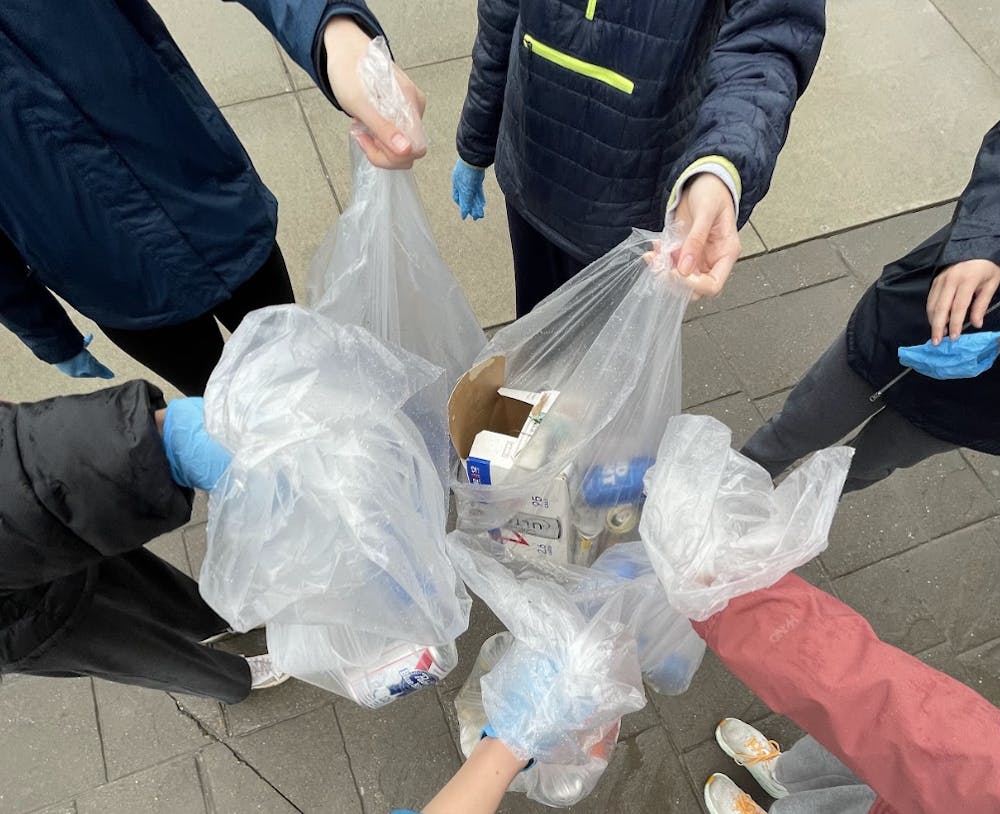As a month-long celebration of Earth Day, Middlebury Athletics took on the “Green Initiative,” a sustainability challenge spearheaded by the Student-Athlete Advisory Committee (SAAC). The program harnesses the competitive spirit of Middlebury’s student-athletes, who have battled this month to see who can pick up the most trash on campus, or which team can get the “perfect sort” of collected waste. More notably, each team has brought their own unique angle to sustainability.
Middlebury is home to an undoubtedly enthusiastic athletic culture and a tradition of success in nearly every sport. At the same time, the college has a storied environmental studies program, proudly maintains “carbon neutrality,” and takes the lead in student-led initiatives aimed at improving institutional environmental practices that often lead to structural change. In recent years, the synergy between these traditions have begun to take hold.
Middlebury Athletics’ sustainability endeavors officially began in 2015 with the “Green Panther” program — despite the slowed efforts during COVID-19 to promote dialogue about sustainability and expand sustainable practices across the department, the SAAC Sustainability Committee is now renewing these efforts with full force. Since fall 2021, each varsity team has had a “Green Liaison,” whose role is to ensure the proper sorting of trash and recycling and assume responsibility for a compost bucket during travel and away games. This year, the liaison’s key task is to lead their team to success in the annual Green Initiative: a team-specific, student-led sustainability effort.
Caroline Adams ’26 heads the SAAC Sustainability Subcommittee alongside co-president Shea Brams ’26. Adams spoke about the challenges the committee has faced and her excitement about the future of sustainability in athletics. The impact of these initiatives varies sport by sport, according to Adams.
“For now, the impact can be small. What is important at this stage is that each team’s approach starts a conversation about how to be more sustainable, and once it becomes a habit I think we will start to see a large change,” Adams said.
The program is young — but even the impact of the football team's nearly 100 players, working in groups of 10 to clean up the waste leftover from tailgates, has yielded a significant impact this year.
Since SAAC’s revival of the sustainability subcommittee, examples of these small yet consequential efforts have become increasingly visible, including several creative solutions to minimize waste. For example, if you see a lacrosse player refining their mastery of “wall ball” with a tennis ball, chances are that this ball used to belong to the Middlebury tennis team. This season at Ralph Myhre Golf Course, you might notice recycling bins at every hole or players replacing plastic tees with wooden ones. While celebrating the women’s lacrosse team’s undefeated regular season, perhaps you recognized the swap from disposable to reusable silverware at the team tailgate.
In the evening, one might spot the women’s volleyball team, who have outlawed driving to practice, hoping to reduce emissions and enjoy valuable team bonding by walking to and from the athletic center. The tennis teams are hoping to donate worn-out balls and racquet strings to a community organization, but in the meantime, have found a new use for what they might have once been considered trash.
Looking forward, Adams and Brahms hope to grow student-athletes’ engagement with these issues and efforts.
“We are hoping to bring in guest speakers to discuss sports, sustainability, and climate justice to start these conversations and make sustainability a more central part of athletics at Midd,” Adams said. “I think getting everyone together for these valuable conversations, something like, for example, the Aaron Taylor discussions about diversity, equity, and inclusion, will be really impactful.”
Post-doctoral Fellow Markus Gerke has worked closely with the SAAC Sustainability Subcommittee to discuss how sports intersect with issues of environmental justice, and how effective climate-related work has operated in sports organizations outside of the Middlebury community.
“I believe that initiatives for environmental justice and sustainability need not be associated with more negative terms such as ‘reducing’ or ‘limiting’ -- as if ‘greener sport’ would automatically mean ‘less sport’. Instead, I think it can be incredibly exciting and empowering to envision what changes could make our sporting practices more sustainable and how we can use the power of sport to also contribute to environmental justice,” Gerke wrote in an email to The Campus.
There remains much room to improve upon in Middlebury Athletics' approach to sustainability. The urgency of the climate crisis demands involvement from the entire community and it is clear that student-athletes are starting to do their part. Demonstrating this new momentum, the Green Initiative board hangs proudly in Peterson Athletic Complex, gleaming with Middlebury sports’ efforts to improve their environmental impact.
For updates on the ongoing sustainability efforts across Middlebury athletics, check out @middsaac on Instagram.
Editor’s note: Lexi Linafelter is a member of the women’s volleyball team and a sports editor for The Campus.




